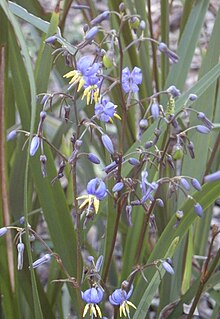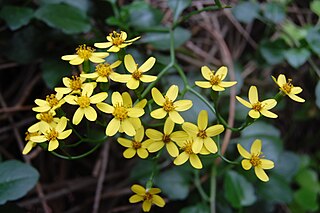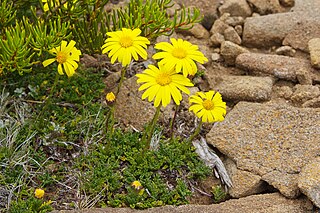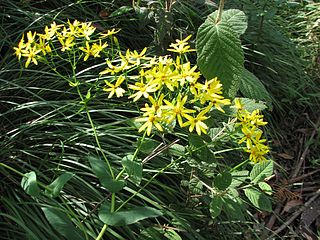
Senecio is a genus of the daisy family (Asteraceae) that includes ragworts and groundsels. The scientific Latin genus name, Senecio, means "old man."

Dianella caerulea, commonly known as the blue flax-lily, blueberry lily, or paroo lily, is a perennial herb of the family Asphodelaceae, subfamily Hemerocallidoideae, found across the eastern states of Australia and Tasmania. It is a herbaceous strappy perennial plant to a metre high, with dark green blade-like leaves to 70 cm long. Blue flowers in spring and summer are followed by indigo-coloured berries. It adapts readily to cultivation and is commonly seen in Australian gardens and amenities plantings.

Atriplex cinerea, commonly known as grey saltbush, coast saltbush, barilla or truganini, is a plant species in the family Amaranthaceae. It occurs in sheltered coastal areas and around salt lakes in the Australian states of Western Australia, South Australia, Tasmania, Victoria and New South Wales.

Senecio angulatus also known as creeping groundsel and sometimes as Cape ivy is a climbing succulent perennial from the family Asteraceae of the genus Senecio; a native of South Africa an alien in Australia, a problem weed in New Zealand, naturalized in North Africa, and cultivated elsewhere.
Crassula colorata, the dense pigmyweed or dense stonecrop, is an annual plant in the family Crassulaceae. The species is endemic to Australia, occurring in Western Australia, South Australia, New South Wales and Victoria.

Brachyscome ciliaris, commonly known as variable daisy, is a small bushy perennial herb with a prominent flower, which occurs throughout most of temperate Australia

Bulbine semibarbata, commonly known as leek lily, native leek or wild onion, is a species of annual herb native to Australia.

Daucus glochidiatus, commonly known as Australian carrot, Austral carrot or native carrot, is a species of herb in the flowering plant family Apiaceae. It is native to Australia and New Zealand.
Nicotiana occidentalis, commonly known as Native Tobacco, is a short-lived herb native to Australia.

Erodium cygnorum is a species of herb native to Australia.
Euchiton sphaericus is a herb native to Australia, New Zealand, New Caledonia, Taiwan, Java, and Philippines. It has become naturalized in a few places in the United States.

Parietaria debilis, commonly known as Pellitory or Native Pellitory, is a herb native to Australia and New Zealand.
Plantago debilis is a species of herb native to Australia. Common names include shade plantain and weak plantain.
Senecio glossanthus is an annual herb native to Australia. In Western Australia it is commonly known as slender groundsel.

Trichodesma zeylanicum, commonly known as camel bush or cattle bush, is a herb or shrub native to Australia.

Brachyscome multifida is a perennial herb in the family Asteraceae. Common names include cut-leaved daisy, rocky daisy, and Hawkesbury daisy. The species is endemic to Australia.

Waitzia acuminata, commonly known as orange immortelle, is an annual herb in the family Asteraceae. It is native to Australia. Plants grow to between 0.1 and 0.6 metres in height and have leaves that are long and narrow. These are between 2 and 10 cm long and 2 to 5 mm in width. The yellow, orange or white flowers appear between July and January.

Dodonaea microzyga, commonly known as brilliant hopbush, is a shrub in the family Sapindaceae. It grows to between 0.3 and 1.5 metres high.

Senecio pectinatus, commonly known as alpine groundsel, is a species of flowering plant in the aster family. The species occurs in alpine areas of south-eastern Australia in peat-based soils. It has divided leaves forming a basal rosette and produces a single yellow flower head on a stalk up to 20 cm high.

Senecio velleioides, commonly known as forest groundsel, is a species of flowering plant in the family Asteraceae.


















